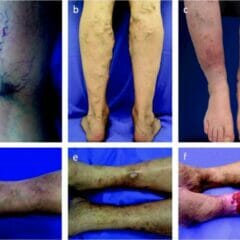Playlist
Show Playlist
Hide Playlist
Varicose Veins: Definition
-
Slides 09 VascularMedicine advanced.pdf
-
Download Lecture Overview
00:01 Hello! We’re continuing with Advanced Vascular Medicine. And we are continuing to speak about venous diseases. 00:08 In this segment, we’re going to talk about varicose veins and venous insufficiency. In other words, inadequacy of the veins to do their job normally. 00:21 So what are varicose veins? Varicose veins are externally visible veins. They’re dilated and tortuous and they’re seen in the lower extremity. And they’re often the result of gravity which, of course, as you know increases the pressure inside the vein and, and particularly with a certain genetic kind of predisposition, the veins dilate and become easily visible on the surface. 00:49 And as you can see here in the figure, the varicose veins are clearly seen on the left-hand figure where they are evident on the surface whereas in the normal, healthy leg on the other side, the veins are not visible. 01:06 There are various forms or various causes, or subdivisions if you will, of varicose veins. 01:14 There are primary varicose veins. They originate from the superficial saphenous vein in the leg and they usually don’t cause much trouble. 01:24 The ones that cause more trouble are the secondary ones that result in impaired flow in the deep venous channel. And this increases the risk for deep venous thrombosis. It occurs commonly in patients who’ve had earlier deep venous thrombosis. So now they can have recurrent venous thrombosis. In some people it’s congenital. There are genetic predispositions to this. 01:51 Pregnancy of course markedly increases the pressure in the lower extremities because the pregnant uterus is sitting on the inferior vena cava and the iliac veins and therefore increasing pressure below the pelvis in the leg. And of course, if these varicose veins connect up in a system where there’s internal varicose veins, then the valves don’t work, blood tends to pool in these veins and edema – or swelling – results. And again, as we’ve talked about in the last lecture, the swelling can even become so severe that it impairs tissue nutrition and you have death of tissue – necrosis – and ulceration. 02:37 Varicose veins are very common entities. Interestingly enough by the way, they’re related to hemorrhoids. 02:42 Hemorrhoids are varicose veins of the anus. But what we’re speaking about here are varicose veins in the leg. 02:49 So let’s talk a little bit about what are the mechanisms that lead to varicose veins.
About the Lecture
The lecture Varicose Veins: Definition by Joseph Alpert, MD is from the course Venous Diseases.
Included Quiz Questions
Which statement about varicose veins is TRUE?
- Varicose veins are the result of dilation of superficial veins.
- Varicose veins are always invisible.
- Most varicose veins develop in the upper arm.
- Deep venous thrombosis is a common complication of primary varicose veins.
Where are varicose veins most commonly found?
- Lower limbs
- Upper limbs
- Torso
- Buttocks
- Face
Customer reviews
5,0 of 5 stars
| 5 Stars |
|
5 |
| 4 Stars |
|
0 |
| 3 Stars |
|
0 |
| 2 Stars |
|
0 |
| 1 Star |
|
0 |





